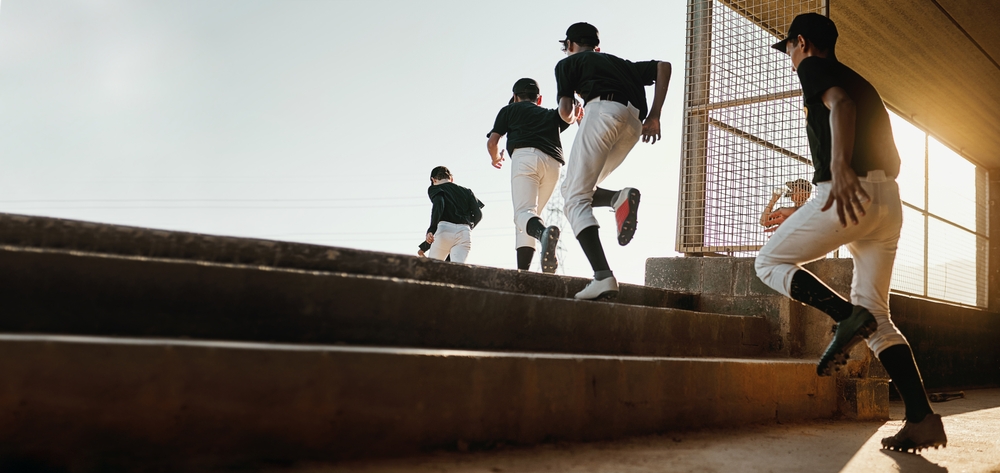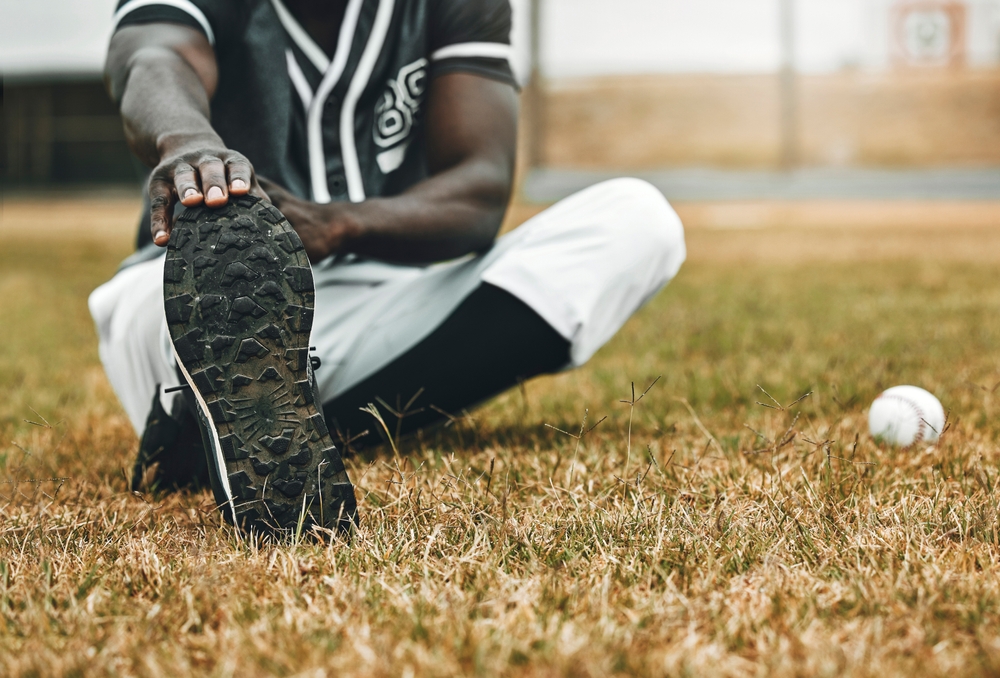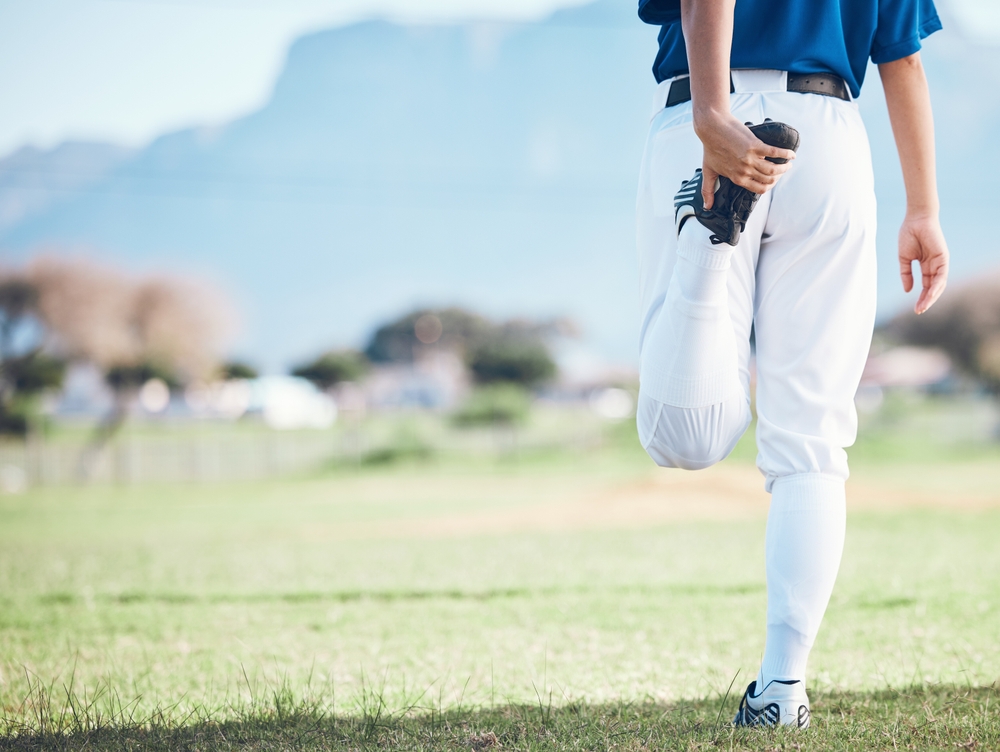
Stretching is a vital part of your youth baseball player’s workout routine. Whether training in the off-season or adding a more structured workout during youth travel baseball season, working out should be done correctly. It’s ideal to mix stretches, drills, and baseball-specific training into a workout routine to improve muscle memory and overall fitness.
But most importantly, Have fun! If you want to take your game to the next level, working out is one way to do that. Our guide to stretches for youth baseball players covers all aspects of your game so you can elevate your performance.

Stretching is essential for youth baseball players, especially if the player is undergoing growth spurts and maturity. As their muscles and bones grow, youth athletes are prone to tightness and reduced flexibility, which can increase the risk of injuries. Regular stretching helps alleviate these issues, promoting overall muscle health and joint mobility.
Stretching should be done properly. It helps the muscles and joints be more flexible so they can handle sudden and quick movements. The benefits of stretching for youth baseball players are numerous.
Muscles and tendons can become tight for youth who are growing into bigger bodies, leading to increased injury risk. Stretching helps maintain flexibility, which is crucial for preventing common baseball injuries such as strains and sprains in the shoulders and thighs. It also improves muscle elasticity, allowing for a greater range of motion, which is essential for batting and field. Stretching before physical activity can reduce the likelihood of more serious injuries.
Stretching prepares the muscles for physical activity, enhancing overall performance during a workout or a game. Flexible muscles allow for better mechanics in throwing, batting, and fielding. Dynamic stretches before a workout and static stretches afterward ensure your muscles are both primed for activity and effectively cooled down. You don’t want to be sore and stiff afterward. Stretching can improve recovery after your workout.
Post-workout stretching helps youth baseball players reduce muscle soreness and speed up recovery. Stretching can facilitate the delivery of nutrients necessary for muscle repair. This is especially important for young athletes who may have multiple practices or games in a week during youth travel baseball season.
Developing a habit of regular stretching can benefit youth baseball players in the long run. Consistent flexibility training contributes to better posture, reduced muscular imbalances, and a lower risk of injuries that keep coming back. Maintaining flexibility will help your player adapt to the physical demands of more advanced levels of play.
Stretching routines can also serve as a mental preparation tool, helping athletes focus and calm their minds before games and practices. This aspect of stretching is often overlooked but is crucial for maintaining a balanced and attentive mindset. While stretching, you can practice visualization about your hitting routine, stealing a base, or making a play in the field.

There are two basic types of stretching for youth baseball players to understand. There is dynamic stretching, where movement is constant and static stretching, where you hold a stretch for a short period of time without movement.
Dynamic and static stretching both play crucial roles in the training routines of youth baseball players, but they serve different purposes and should be incorporated at different times during workouts.
Dynamic stretching involves moving muscles and joints through their full range of motion. For a youth baseball player, this would involve stretches that help your throwing or batting motion. It’s best to perform dynamic stretching before engaging in physical activity. The goal of dynamic stretching is to improve blood flow, elevate heart rate, and prepare muscles for the demands of baseball practice or a workout. Examples of dynamic stretches include leg swings, arm circles, walking lunges, high knees, and butt kicks.
Dynamic stretching is particularly beneficial for youth baseball players in several aspects.
Static stretching involves holding a stretch for a period of time, typically between 15 to 30 seconds. Perform static stretches after physical activity as part of the cool-down routine toward the end of your workout routine. The main purpose of static stretching is to aid in muscle recovery and prevent injuries after a workout routine.
Common static stretches include touching the toes while seated, calf stretches against a wall, and standing quad stretches.

Incorporating both upper and lower body dynamic stretches into a pre-game or pre-practice routine helps you prepare for the best possible experience. Remember, stretching also can prevent injuries for youth travel baseball players.
Consider these five dynamic stretches for your upper body ahead of engaging in a more intense workout.
These stretches help your shoulders get loose ahead of throwing and hitting movements.
Torso twists help get your lower back ready for the motions you need for hitting and fielding. You’ll need to make explosive movements for both skill sets.
Shoulder shrugs offer a different motion compared to arm circles. Rather than moving the shoulder in a circular pattern, this is more focused on the up and down movement.
Just like a swingset, the motion of your arms in this stretch is with an underhand motion. Arm swings loosen up the shoulder and upper back.
How your shoulder connects to your back is an important part of your movements in youth baseball. This stretch helps to strengthen the muscles around the shoulder blades ahead of higher-level workouts.
These five dynamic stretches for your lower body can help loosen the muscles ahead of practice, workout, or youth baseball game.
Leg swings are just like arm swings, where you move each leg in a motion that exercises the hip and hamstrings.
Lunges use your body weight to help stretch your upper legs and hips. Take it easy and slow with lunges.
Focus on the knees when jogging in place. The goal is to help your knees get used to bending motions ahead of a workout. It also stretches the hips and increases your heart rate.
Rather than bringing your knees to your chest, this stretch is about flexing your knees in the opposite direction.
This stretch is a little different from leg swings. The goal is to move one hip in a circular pattern while balancing on the other leg.

Now that you’re warmed up with general dynamic stretches, we’ll go over baseball-specific dynamic stretches that help you with various aspects of your game.
Rather than lunging forward, a lateral lunge moves to the side. This stretch is perfect for your base-stealing moves. It also gets you ready for a fielding play.
Have you ever skipped while you walk? A lateral shuffle is a lot like skipping, but only to the side.
Skipping works out the groin, hips, legs, and arms.
We all remember jumping jacks from elementary school. It’s a great full-body stretch that gets your heart rate up while stretching arms and legs.

After your workout, practice, or youth baseball game, cooling down is an essential way to keep your muscles strong and healthy while reducing soreness after a workout.
Here are five upper-body cool-down stretches to perform as you wind down from practice, a game, or a workout.
Your chest serves as an anchor point for your arms and torso, and it’s important to keep it in great shape for baseball. This stretch can help you keep your chest muscles loose.
Keep your upper back limber with this easy stretch.
When you flex, that’s your biceps doing the talking. Stretch them after a workout with this easy one.
Your head needs to move and react quickly to the baseball. Support your next with this stretch.
Keep your ribs, chest, and torso in shape with this stretch.
See these five lower-body stretches to help your legs, torso, and back recover from a workout.
Give your calves a rest with this stretch.
Your hips carry a lot of workload during a baseball game. Keep them in great shape with this post-workout stretch.
You might feel your back stretch with this one!
This is a common stretch that also helps your legs.
This is an easy stretch that also helps you balance.
We want you to get the most out of your workout routine! Maximize the benefits of stretching with these quick tips.
We want your youth baseball player to get the most out of their time and efforts. If you have any questions or want to book your team for a tournament, contact us at Ballparks of America or call (417) 464-6333.